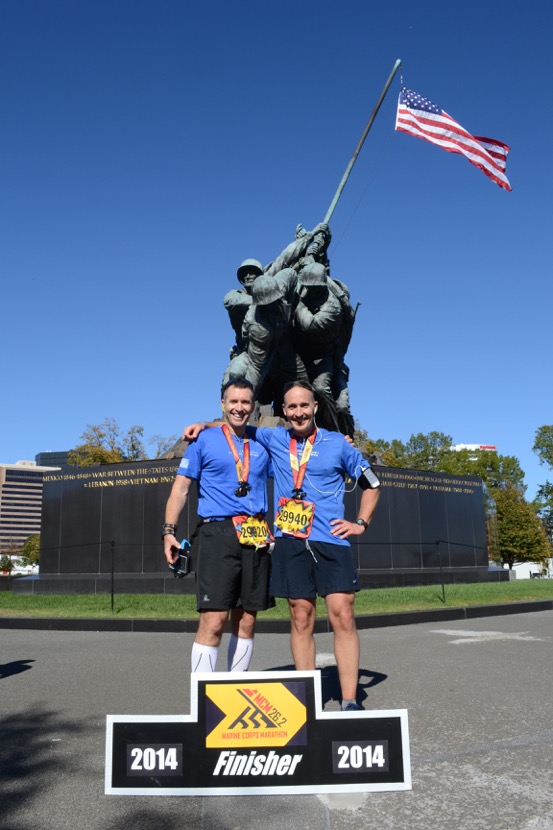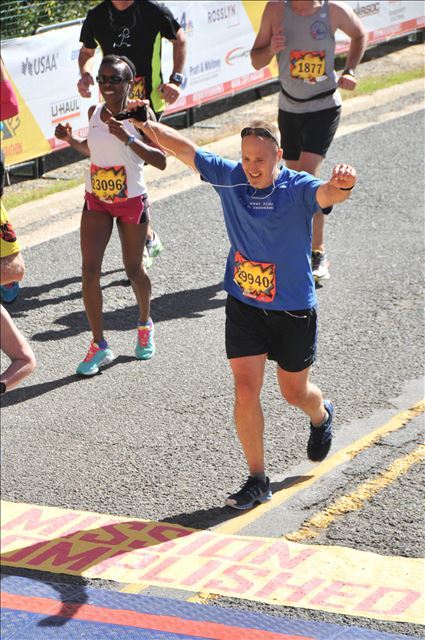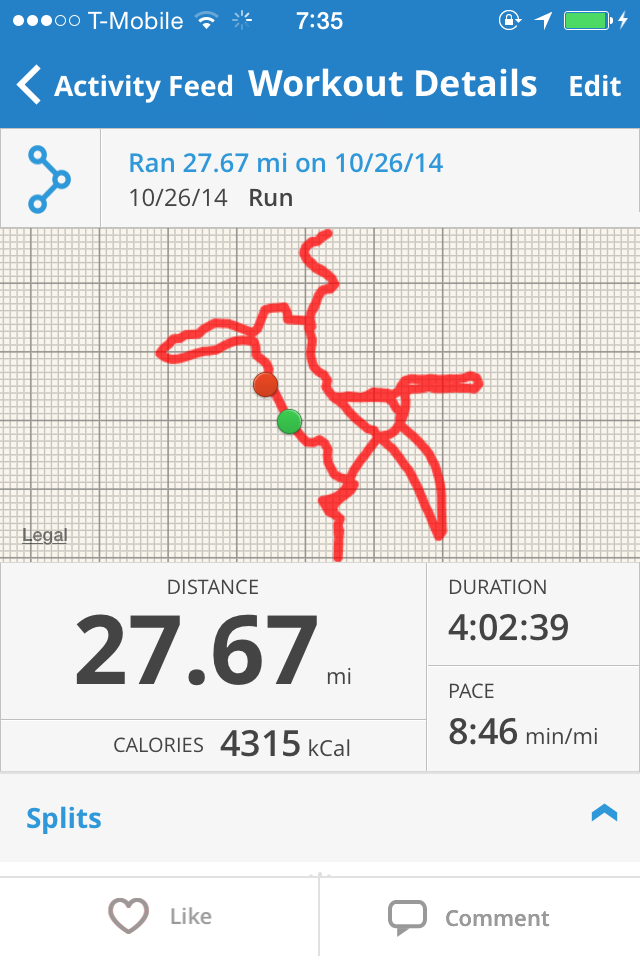Why Learning a Language is Like Running a Marathon Posted by bnelson on Apr 15, 2015 in Archived Posts
I have a confession to make. For the better part of my adult life, I have devoured numerous books, blogs, and websites about performance improvement – without seeing any actual improvement! I’ve had the desire, the internal drive to improve… but with an equally powerful ability to rationalize my way out of hard work.
For much of my adult life, I have struggled to achieve certain goals because I was looking for some kind of easy hack. In short, I am a product of the ‘Easy Button’ American Culture. Not proud of it, but it is true. I am inherently opposed to hard work.
With that in mind, I want to share an experience of accomplishing a bucket list item. I want to tell you about the time my brother Alan and I completed the Marine Corps Marathon in Washington, DC, finishing with respectable times of 4:03:52 and 4:04:02. Alan says that it wasn’t even close…he smoked me!
What does running a marathon have to do with learning a foreign language? I’d say they are damn near the same thing when it comes to the brutal, punishing amount of pure ‘road work’ required for both endeavors.
As a soldier, I stay relatively fit. In fact, I think most soldiers could probably finish a half marathon with little advanced notice. Maybe not quickly, and not without the secondary costs of chafing, blisters, and sore IT bands afterwards—but most of us could probably finish.
That is not the case with a full marathon. Without the requisite number of miles under one’s belt, I think most would fail, buckling physically and/or mentally under the pressures that a marathon delivers. I’m not talking about the outliers, but I’m talking to the rest of us stuck in the big, fat, middle of the bell curve.
Learning a foreign language is like that. You’ve got to put in the miles. There is no way around knowing vocabulary, period. And learning vocabulary cannot be accomplished by sleeping on a dictionary or listening to language tapes while you’re asleep or otherwise distracted. The words must be pounded into your brain. This takes conscious effort. Myelin only wraps around neural pathways from deliberate practice, and the work must be effortful. Frustration is the learning zone.
So, back to this crazy idea of wanting to run a marathon…here were my immediate reflections: It is the most solitary event in which I have ever participated with 20,000 other people. It was 2 ½ hours of joy followed by 94 minutes and 4 seconds of abject suffering. My happy place was a distant galaxy around mile 22, and I was in an absolute knife fight with myself to finish.
So how did this inherently lazy guy actually cross this item off of his bucket list?
Bucket lists are interesting. When does an idea become action? Alan and I talked about it for years, but once we started using MapMyRun, action overtook rhetoric. MapMyRun is only one of hundreds of the apps, ‘wearables’, and websites that comprise the growing movement of ‘Quantitated Self’ (QS), or improvement via self-data collection.
As a career soldier, the quickest way to limit or end your career is to fail (or “Bolo” in Army vernacular) the Army Physical Fitness Test (APFT), or exceed the height/weight standards. The Army frowns on fat-bodies.
The last decade of my own fitness began while deploying to Afghanistan. A friend of mine said that deployments are the, “300 Club. After a year-long deployment you either weigh 300 or you can lift 300. The choice is yours.”
While I never could flat-bench 300, I did fall into the ‘prison-yard’ lifting routine overseas. Towards the end of my deployment, a few guys introduced me to CrossFit, which added an element of competition to working out We kept score and I loved it. It wasn’t until I decided to write this article that I realized ‘keeping score’ is QS at its core.
From 2006-2012, I was much more of an anaerobic athlete than a long-distance runner. I worked in downtown Tacoma, and after work I’d run the stairs at Stadium High School each day. Running the stairs suited me. A fast, brutal workout that I could complete in 25 minutes or less.
But then in early 2012, my routine was disrupted. I changed jobs and locations. I had to work at the dreaded State HQ, 15 miles away from Stadium High School. New environment, new people, and no stairs to get my run on… frankly I was in a bit of a funk. I needed to find a substitute for my afternoon workout. I had read somewhere about the magic number of 20. Run or walk 20 miles a week to stay thin. I decided to substitute my stairs for a 4-mile run after work each day.
2012 is also the time that I finally succumbed to the smart phone revolution…I was a late majority at best, laggard and borderline Luddite at worst. My younger, tech-savvy friends were consistently harassing me about using my government-issued Blackberry. I’d say, “email is for GenXers! Texting is for Millenials!” So, yeah, I guess I’m a Luddite.
I combined my running with this new technology, using MapMyRun and the Nike running app. This is where things began to get interesting. Below are the monthly totals on my Nike app when I decided to run:
- October: 51.8
- November: 58.6
- December: 98.9
- January: (a lousy time to run in Tacoma, WA!) 132
- February: 47.9 (I ended up injuring myself by over-training)
- March: 70.6
Once I started measuring my efforts, I wanted to improve them all on my own. Admittedly, I improved them so much that I injured myself, but that is also part of the learning process.
My own experience is that by simply measuring, tracking, and reflecting on any behavior, we will strive to improve or change this behavior.
The surprise in all of this? I began to fall in love with running again. The work no longer seemed to be work, and there was a new fuel; mastery. A little bit of mastery is a powerful incentive. Dan Pink, author of “Drive” writes that true, long-term motivation, intrinsic motivation requires autonomy, mastery, and purpose. QS monitoring touches all three of those, but especially mastery. Fitness apps detail all sorts of data: miles, speed, elevation, temperature, pace, and even how you compare statistics.
So back to the marathon. Once Alan and I had both started using mapping functions on our phones to measure our runs, the bucket list idea of running a marathon leapt to our consciousness. We used MapMyRun to ‘virtually’ train together, commenting on each others’ workouts, keeping each other honest. The road work became almost joyful. We had a long-term objective that was attainable, and seeing each long run cataloged continued to feed my motivation.
Now, there are millions of people that have run marathons without this technology, but I do believe that the spike in races–people completing 5Ks, 10Ks, half-marathons, and marathons–can closely align with smart phone technology and the QS movement.
So… to learn a language? Choose an app or program that gives you the best feedback.
For numerous reasons, Transparent Language is the absolute best technology I’ve found for learning and maintaining a language, but what really strikes a chord with me is the increase in Learned Items and the ‘stale vs fresh’ component. It is feedback. It is data. It links to our deeper drives.
Here’s another way to look at it. It takes about 10 minutes to go through a list on the CL-150 (the government version of the software). 10 minutes a day, 5 days a week, for 50 weeks aggregates to 41.66 hours of study. That is 10 hours longer than taking a college class. That helps build one’s own sense of efficacy, mastery.
Learning a language is hard work. There are no shortcuts. However, there are smart-cuts. Once we begin to see just a bit of feedback, if we can stick with a habit long enough for some data to aggregate—then intrinsic motivation kicks in, and we’ve developed a lifelong habit.

Build vocabulary, practice pronunciation, and more with Transparent Language Online. Available anytime, anywhere, on any device.






Comments:
Rentalic:
Learning a language is not an east task we have to talk with the people around us weather we are talking it rite or wrong we have to continue our practice and we could learn it easily.
Brian:
Thanks Rentalic,
I agree that it is not easy. Our culture wants us to believe that everything is ‘Easy Button’. Nothing could be further from the truth. The humility required to make mistakes, when speaking or writing is hard. We gotta put in the miles…
Thanks.
bsn
Eva:
Thanks for writing this article – you speak from my soul! Keeping track of your improvements – or even efforts if not always entirely successful – is a great source of motivation! Being a runner, my bucket list item is the marathon in sub 3:20:00. Being a language learner, I am struggling every day to keep the (especially hard-learned second-) foreign language alive; both, I am convinced, works with regular repetition and appropriate “training stimuli”, be it the Word of the Day in the inbox or the virtual race with a buddy to tackle a new personal record.
Keep up you great work!
Eva
bnelson:
@Eva Eva,
1: 3:20 is RID-DONK-ULOUS!!!! I didn’t hit a wall at the MCM, it was more like a city block. That is one impressive bucket list item. Are you running Monday in Boston?
2: After years of thinking about it, I’m convinced that it is much easier to quit on oneself than to quit on a buddy. Double days in August, CrossFit, speed work, max effort things. I wish it wasn’t so for myself, but that is like wishing everyone had a unicorn. I have been doing the CrossFit Endurance running workouts. Sprints are so much harder than a long-slow run. It is total mental anguish. Say the workout is 12 200m sprints. By 5, my mind is already saying to me, “Hey man, 6 is enough. No one does sprints. You’re 45 years old! Settle down.”
When I do these with a buddy, I keep my internal crazy internal–and run harder each sprint.
I think languages are even harder. The direct feedback does not include a dopamine rush. The next step is to create small communities, tribes if you will, that ‘workout’ together. I’m convinced if peer pressure can influence one to smoke, it can work to study foreign language.
Thank you for your kind reply.
bsn
Eva:
@bnelson I totally agree: the feedback in learning a language is a lot more indirect, maybe because it is harder to take note of your own improvements. While I can check my Garmin protocol to tell me how fast I did the 400 m repetitions a year ago in comparison to the ones yesterday, it is almost impossible to measure whether I have increased my Spanish vocabulary corpus, for instance.
I took me a while to find my small Spanish-learning community with members on roughly the same level – being on an equal level is crucial, too, I suppose: if my training buddy is too far ahead (or behind), it is like struggling on my own again. (By the way, for me it is those dreadful long-slow jogs that challenge my mental strength…)
No, no Boston for me – I am 3,600 miles away… Maybe Frankfurt in October.
Take care,
Eva
Transparent Language:
@Eva Hey Eva!
If you’re looking for a system to directly measure your vocabulary growth over time, check out Transparent Language Online. It features our retention system, called Learned Items, which measures how many vocabulary words and phrases you’ve learned over time, including a nice graph that shows the trajectory. Best of all, the system will remind you when those Learned Items go “stale” over time, prompting you to revise them and keep them “fresh” in your mind. 🙂
You can learn more and see it in action for yourself in a free trial, if you’re interested: http://www.transparent.com/personal/transparent-language-online2.html